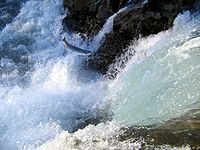
Photo from wikipedia
During multiple annual spawning runs from 2013 to 2021, over 9,000 mature anadromous alewife (Alosa pseudoharengus A. Wilson, 1811) were monitored with passive integrated transponders (PITs) in four rivers of… Click to show full abstract
During multiple annual spawning runs from 2013 to 2021, over 9,000 mature anadromous alewife (Alosa pseudoharengus A. Wilson, 1811) were monitored with passive integrated transponders (PITs) in four rivers of the Chignecto Isthmus, Bay of Fundy, Canada. A subsample of 384 individuals tagged during 2016–2019 were aged from 3 to 6 years (mean ± SD; 4.2 ± 0.7 years, n = 232, males; 4.5 ± 0.7 years, n = 152, females). Biotelemetry revealed that one unsexed individual survived seven years post tagging, possibly making it 10–13 years old. Return rates varied among the rivers, with the lowest rates in the most anthropogenically impacted river. Biotelemetry and ageing data were used to estimate apparent annual survival rates ranging from 0.25 to 0.50 depending on the river and the year. Based on capture-mark-recapture (CMR) analysis of biotelemetry data from the three less impacted rivers, the estimated overall annual survival was 0.396, total instantaneous mortality (Z) was 0.93, and future life expectancy from time of release was 1.08 years. Frequency distribution of ages 4–6 for alewife pooled from all four study rivers estimated a lower annual survival rate of 0.301, Z = 1.20, and a future life expectancy of 0.83 years. The biotelemetry detection rates were 0.89–0.98 but varied depending on the river and the year, with the lowest rates in one river during 2017-2018 possibly related to a malfunctioning tide gate preventing upstream fish passage and subsequent detection. Based on CMR, males had a higher survival rate compared to females, which translated into an overall mean survival increase of 0.05. Alewife survivorship in our study highlighted that a limited ecosystem-based management period is required to mitigate river connectivity and mortality issues to avoid loss of population cohorts and decrease the risk of extirpation.
Journal Title: Journal of Applied Ichthyology
Year Published: 2023
Link to full text (if available)
Share on Social Media: Sign Up to like & get
recommendations!